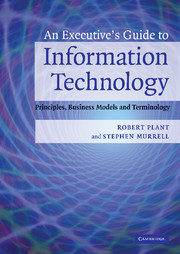Book contents
- Frontmatter
- Contents
- Introduction
- A ACM (Association for Computing Machinery) to Audio
- B Backup to Business process re-engineering
- C C, C++, C# to Cracking
- D Database to Dynamic web pages
- E e-Commerce/e-business to European Union Directive on Privacy and Electronic Commerce 2002
- F Fiber optics to Fuzzy logic
- G to H Global positioning system to Hypertext, HTML
- I ICANN (Internet Corporation for Assigned Names and Numbers) to ISP (Internet service provider)
- J to L Java to Logic programming
- M Machine learning to Multicast
- N Natural language processing (NLP) to Normalization
- O Object-oriented to Outsourcing
- P Packet switching and circuit switching to Public key-private key
- Q to R Quantum computing to RSS (Really simple syndication)
- S Sarbanes-Oxley Act of 2002 (SOX) to Structured design methodologies
- T to U T-Carrier to URL (Uniform resource locator)
- V Value added network (VAN) to Voice over IP (VoIP)
- W W3C (the World Wide Web Consortium) to WYSIWYG
- X to Z X.12 to Zip
- Index
- References
V - Value added network (VAN) to Voice over IP (VoIP)
Published online by Cambridge University Press: 17 May 2010
- Frontmatter
- Contents
- Introduction
- A ACM (Association for Computing Machinery) to Audio
- B Backup to Business process re-engineering
- C C, C++, C# to Cracking
- D Database to Dynamic web pages
- E e-Commerce/e-business to European Union Directive on Privacy and Electronic Commerce 2002
- F Fiber optics to Fuzzy logic
- G to H Global positioning system to Hypertext, HTML
- I ICANN (Internet Corporation for Assigned Names and Numbers) to ISP (Internet service provider)
- J to L Java to Logic programming
- M Machine learning to Multicast
- N Natural language processing (NLP) to Normalization
- O Object-oriented to Outsourcing
- P Packet switching and circuit switching to Public key-private key
- Q to R Quantum computing to RSS (Really simple syndication)
- S Sarbanes-Oxley Act of 2002 (SOX) to Structured design methodologies
- T to U T-Carrier to URL (Uniform resource locator)
- V Value added network (VAN) to Voice over IP (VoIP)
- W W3C (the World Wide Web Consortium) to WYSIWYG
- X to Z X.12 to Zip
- Index
- References
Summary
Foundation concept: Network.
Definition: A communication network provided by a third-party vendor that also provides guarantees of service quality, security, and reliable data transmission.
Overview
Value added networks (VANs) are provided by third parties such as the common carriers (telecommunications providers) which lease secure telecommunication connections to subscribers. VANs provide a variety of services together with the connection, including support of a variety of EDI standards (such as ANSI X.12, EDIFACT, and XML), data security standards (for data encryption, a Secure sockets layer, etc.), multiple levels of password authorization, and communication protocols such as X.25 and TCP/IP.
Business value proposition
VANs provide secure networks capable of high-bandwidth data transmission that range from T1 at 1.544 Mbps to OC48 at 2.4 Gbps, together with service-quality guarantees and data security services. The decision to purchase may be based upon the technical need together with the financial aspects of the lease: subscribers pay a base fee plus per-service costs. The analysis of total cost of ownership has to be based upon the use of and need for the services. VANs offer a variety of services and charges are based upon their usage: the amount of data transmitted, fees for connections to other VANs, mailbox charges, help-desk service charges, data-archiving fees, service plan fees, and user and technical training fees.
Summary of positive issues
VANs provide a secure, high-quality, professionally managed and maintained mechanism for connecting with other organizations and entities.
- Type
- Chapter
- Information
- An Executive's Guide to Information TechnologyPrinciples, Business Models, and Terminology, pp. 329 - 345Publisher: Cambridge University PressPrint publication year: 2007



